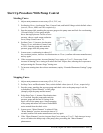
RVS-DX, Digital Soft Starter Instruction Manual—4/01/04
8-3
Troubleshooting
Upon fault the motor stops, “Fault” LED illuminates and fault relay operates. The LCD will display
“Trip: fault description”.
Check “Statistical Data” for additional fault-related information.
Fault Description
ALARM: INSULATION (Optional) Initiates a signal when motor insulation level decreases below set level.
TRIP: INSULATION (Optional) Trips the starter when motor insulation level decreases below trip value.
Check motor and cable insulation level.
TRIP: THERMISTOR (Optional) Trips the starter when motor’s thermistor resistance decreases below trip
value. Check thermistor and cable’s resistance; check motor temperature near
thermistor location.
TOO MANY STARTS Trips the starter if the number of starts during “Start Period” exceeds the preset
number. Wait until motor and starter cool down–according to “Start Inhibit” setting.
LONG START TIME Trips the starter if output voltage does not reach nominal at the preset time. Check
“FLA”, “FLC” and “Max. Start Time” settings. Increase “Initial Voltage”, “Current
Limit” and “Max. Start Time” settings or decrease “Acceleration Time” as necessary.
O/C–SHEAR PIN The electronic fuse trips the starter instantaneously when current exceeds 8.5 X FLA
during starting or 200-850% during running. Check “FLA”, “FLC” settings, motor
and cable connections. Check that the motor is not stalled.
OVERLOAD Trips the starter when current exceeds the Overload Trip level and thermal register has
filled up. Check “FLA”, “FLC” and “Overload” settings, and check the motor current.
Wait 15 minutes to let the motor and stater cool down before starting.
UNDERCURRENT Trips the starter when line current drops below the preset level for the preset time.
Check “Undercurrent Trip” and “Undercurrent Delay” settings. Check line current
through L1, L2, and L3.
UNDERVOLTAGE Trips the starter when line voltage drops below the preset level for the preset time.
Check “Undervoltage Trip” and “Undervoltage Delay” settings. Check line voltage
through L1, L2 and L3.
OVERVOLTAGE Trips the starter when line voltage rises above the preset level for the preset time.
Check “Overload Trip” and “Overvoltage Delay” settings. Check line voltage through
L1, L2 and L3.
PHASE LOSS Trips the starter if 1 or 2 phases are missing. Check line voltages through L1, L2 and
L3. Check that the frequency variations are between 45 to 65 Hz.
PHASE SEQUENCE Trips the starter if input phase sequence is wrong. Check line phase sequence and if
wrong, swap two wires on the line side. If the motor rotates in the wrong direction,
swap two wires on the load side.
MAX. SLOW SP TIME Trips the starter when operating at slow speed for extended period of time. Check that
operation time at Slow Speed is shorter than the “Max. Slow Speed Time” setting.
NOTE: Motor and starter may overheat when operating at slow speed for an extended
period of time.
WRONG CONNECTION Trips the starter when motor is not properly connected to load terminals.
SHORTER SCR Trips the starter and prevents starting if one or more SCRs are short circuited or when
motor windings are shorted. Check with an ohmmeter between L1-U, L2-V and L3-W,
resistance > 20 KΩ.
SCRs may fail due to:
• High short current not protected by proper fuses.
• High voltage spikes not protected by proper external varistors.
• Frequent starting at max. conditions or fault conditions.
OVERTEMPERATURE Heatsink overtemperature. Trips the starter when the heatsink temperature rises above
85°C. Improve cooling. Check the motor staring is not too frequent.
EXTERNAL FAULT Trips the starter when a N.O. contact between terminal A2 and C1 closes for over two
seconds. Check contact position and cause of closure.


















